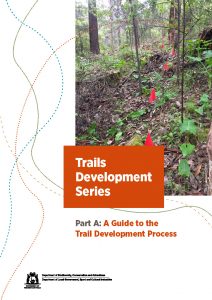Now more than ever, sustainability is at the forefront of bridle trail planning, design and construction. Sustainability involves meeting the needs of the present without compromising the ability of future generations to meet their needs, with a focus on three pillars: environment, society, and the economy. Sustainable bridle trails include developing the right trails, in the right places, the right way and for the right reasons.
The 8 Stage Trail Development Process, outlined in the WA Trails Development Series (2019) is commonly used for the planning, design, construction and maintenance stages of a project and includes standardised best practices for sustainable trails. Working within a standardised methodology is important in high conservation areas where trail planning, design and construction needs to be completed correctly the first time. Understanding landforms, soil types and landscape features is key to designing sustainable trails.

Image: WA Trails Development Series, best practice trails document
A detailed design process ensures high quality and long term sustainable trails that are fit for purpose and require low management and maintenance. Sustainable bridle trail planning and construction should be a robust, rigorous and coordinated approach. The planning process should involve in depth research, engagement of expert knowledge and consultation with a wide range of stakeholders including state and local government, community groups and trail users. A sustainable bridle trail should have a clear framework which includes a governance structure, ongoing maintenance and management models and access to funding.

Image: Community consultation and engagement for the Robinson Precinct and Stidwell Bridle Trail Study
The 8 Stage Trail Development Process coupled with best practice sustainable design principles will result in high quality, well built and well defined bridle trails that are environmentally sound, socially equitable and economically viable. Sustainable bridle trails allow users to access, explore and appreciate pristine and attractive natural areas while having minimal impact on natural and cultural assets. This is particularly important for residents seeking to escape their busy lifestyles and connect with nature.
A sustainable bridle trail that is located within an urban or peri-urban area provides significant health and wellbeing benefits, both mental and physical. Trail utilisation for mental and physical health and wellbeing is gaining in popularity in the current global environment due to COVID 19. The economic facet of sustainability is met via the growing importance of trails and nature based tourism to the visitor and tourism economy and its strong influence on community development.

Image: Darling Downs Bridle Trail, located in the peri-urban Darling Downs Equestrian Estate (Shire of Serpentine Jarrahdale)
Throughout 2021 and 2022, Tredwell have been working on a number of bridle trail projects across Western Australia including the Robinson Precinct and Stidwell Bridle Trail Study for the City of Albany (2021/22), the Jarrahdale Bridle Trail Development Concept Plan for the Department of Biodiversity, Conservation and Attractions and Shire of Serpentine Jarrahdale (2021/22) and the Equine Trails Master Plan for the Shire of Serpentine Jarrahdale (2021/22).

Image: Stidwell Bridle Trail trailhead sign, located at the Albany Equestrian Centre (City of Albany)

